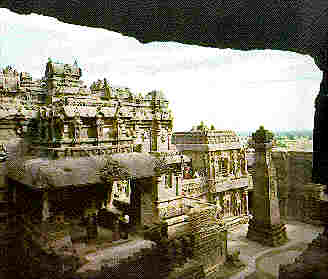
|
- The Two Classes of the Four-Fold Caste System
_____________________
By Sudheer Birodkar
__________________________________________________________________
_________________________________________________
We saw in the last chapter how following the disintegration of the tribal society in which every able-bodied person took part in the productive process, the rise of 2 section comprising Priests and Warriors (Brahmins and Kshatriyas) who did not take part in the productive process, logically meant that now for their own livelihood this section of Priests and Warriors had to appropriate their sustenance i.e. a part of the social product from the productive section comprising the Vaishya cultivators and the Shudra helots.
 | The Ajanta temple complex is unique in a sense that its construction was conceived top-down. The sculptor-craftsmen started carving the roof of the temple from the peak of a rocky hill and worked their way to the foundation at the base of the hill! In the construction of such grand temples, the unpaid labour of members of the Vaishya and Shudra castes called vishti and balutem was also used. Similar systems were followed all across the globe, be it in the construction of the Pyramids in Egypt, the Acropolis in Greece or the Colosseum at Rome. What distinguished the Indian system from that of the ancient Western world is the absence of slavery. The caste system made formal slavery unnecessary in ancient India. |
The Brahmin-Kshatriya combine was thus the appropriating section as against the Vaishya-shudra combine who represented the productive section. But although the two appropriating and the two appropriated sections of society performed different functions like the ritual worship undertaken by the Brahmins, warfare by Kshatriyas, cultivation by the Vaishyas and menial work by the Shudras they were essentially two broad economic categories with antagonistic interests of sharing the social surplus product which only the Vaishyas and Shudra created. Dana and Dakshina for Brahmins and Kar, Shulka, Bali for the Kshatriyas
While the Kshatriyas acquired their share of the social surplus through the force of arms in the form of taxes (kar, shulka, bali, etc.), forced labour (vishti, balutam, etc.), tithes and other privileges. The Brahmin clergy enforced its claim to the social surplus through a moral deterrent which was based on strength of the tribal morality of distribution. The Brahmins who were now not only tenderers of the fireplace any longer, but had come to acquire the status of representatives of Gods on earth} secured their share in the surplus by propagating beliefs that those who looked upon their own needs without a thought of the Brahmins were eaters of sin. This was how the practice of Dana was born.
The practice of Dana was one method of appropriation of the surplus by the clergy. But in this practice, the motivating element was religious faith and not coercion, which is a reflection on how the tribal morality of equi-distribution was seized and wielded by the new social categories in their own interests. How a system, which under the tribal set-up was a guarantee of equi-distribution of the social product among the members of a tribe was turned into a source for the discriminatory enrichment of one section of society. From then onwards till modern times} Dana along with dakshina (a voluntary payment made to Brahmins for religious services which they rendered), has been represented as an offering to the clergy at our innumerable religious rites. Thus the spiritual clasp of the clergy on the general population came to play a vital role in appropriating the surplus in favour of the clergy, rendering coercion unnecessary and in perpetuating social practices which had lost relevance with day-to-day life.
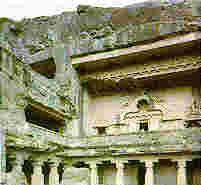 | Here we can see how the sculptor-craftsmen hollowed out the rocky hill at Ajanta to create a masterpiece underground - literally. But one should remember that behind such projects went a lot of unpaid labour and obligations for the Vaishyas and Shudra castes to undertake voluntary unpaid work in the construction of such grandoise complexes. In doing this the clergy firmly rooted in the minds of the masses, ideas about Karma - faithfully carrying out of duties assigned to each person on virtue of being born in any particular caste. Ideas about rebirth fostered a belief that sufferings of this life were a result of deeds of one's past lives and the faithful execution of duties that fell upon one in one's present life would hold a promise of rebirth in a higher caste. With their minds enmeshed in such dogmas, the masses mutely accepted a secondary status in the social hierarchy for centuries together. |
The clergy firmly rooted in the minds of the masses, ideas about Karma - faithfully carrying out of duties assigned to each person on virtue of being born in any particular caste. Ideas about rebirth fostered a belief that sufferings of this life were a result of deeds of one's past lives and the faithful execution of duties that fell upon one in one's present life would hold a promise of rebirth in a higher caste. With their minds enmeshed in such dogmas, the masses mutely accepted a secondary status in the social hierarchy for centuries together.
 | A fresco from the 2nd century C.E. A scene from a courtesan's house (Reproduced from the original sculpture at the National Museum, Delhi.) The tribal morality of multiple pairing between the sexes was later transformed into the oldest profession of humankind. In ancient India, the ladies in this profession were called Ganaika from Gana (tribe) and Veshya from Vis (Common people). |
Limited Role of the Kshatriyas in the Caste System
But as compared to the position of the Brahmins, the role of the Kshatriyas as a definite caste-class is very limited and that limited role was also relevant in the immediate Post-Vedic period. When we hear of the rise of the monarchical states in the Gangetic Valley from the 5th century B.C.E. the rulers and even nobles and warriors were not necessarily people who were born into the Kshatriya caste. Their function itself was such that it could be encroached upon by any powerful outside group. Successful foreign invaders who established themselves in power were known as degraded Kshatriyas till they recognised the higher status of the Brahmins in the caste hierarchy.
A formal acknowledgement of the superiority of the Brahmins was symbolised by the foreign martial races getting themselves baptised, through the ceremony of Upanayana, as Kshatriyas into the Varna system.
The Upanayana - Thread Ceremony - was a tool by which the Brahmins could preserve their hold over the Kshatriyas
The Upanayana ceremony like any other religious ceremony could be performed only, by the Brahmins. After undergoing Upanayana, the Kshatriyas had to pledge to be protectors of Brahmins and recognize the higher status of the Brahmins in the caste hierarchy.
In doing this, the Brahmins had the support of the emotional hold they had over society as a whole by means which they could differentiate between warriors baptised as Kshatriyas and the unbaptised 'degraded' Kshatriyas.
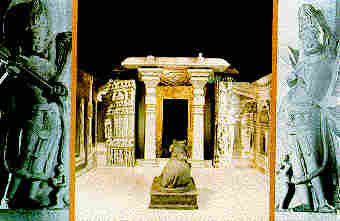 | A reconstruction of a typical South-Indian Temple. Such temples were created and maintained with obligatory services rendered by the lower castes. But despite such voluntary unpaid labour and obligations to render service in temple construction and maintenance, ancient India did not see the emergence of formal slavery. The emotional hold of the clergy over the general population made unnecessary the rise of clear-cut division of society into slaves and slave-owners as it existed in ancient Greece and Rome. |
Brahmins could generally perform the role of Kshatriyas and Vaishyas; but the Vaishyas or Kshatriyas could rarely become priests - Vishwamitra is one exception to this rule.
This was not so with the Brahmins, they generally remained a more endogamous group, although they themselves always encroached upon the functions of the Kshatriyas and Vaishyas whenever these professions proved more profitable. We hear of Brahmin dynasties like the Shungas and Kanvas in ancient India, there also were Brahmin Setthis and Mahasetthis (traders) in those times. But despite this kind of entry into professions reserved for other castes, the Brahmins nevertheless preserved their status as that of clergymen by caste.
This kind of an emotional hold of the clergy in ancient India over the general population made unnecessary the rise of clear-cut division of society into slaves and slave-owners as it existed in ancient Greece and Rome.
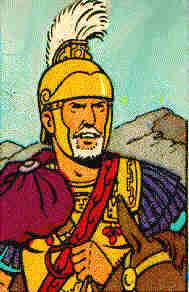 | 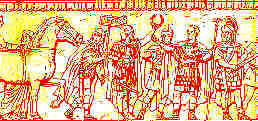 | ____________________ The emotional hold of the clergy in ancient India over the general population made unnecessary the rise of clear-cut division of society into slaves and slave-owners as it existed in ancient Greece and Rome. |
Caste System was Necessary in those days for Economic Progress
But the appearance of the Brahmin-Kshatriya appropriating class was a necessity for further social progress in the material conditions then prevailing. The growing productivity of human labour and the appearance of a surplus product rendered necessary a class that could extract this surplus. The impetus to create this surplus could exist only when there existed no tribal obligation to equally share this surplus product and when the individual ownership of the class which extracted the surplus was possible. In most societies, this surplus was extracted by enslaving able-bodied; persons who could work for their master-owners. Though in India the caste system along with ideas of rebirth and institutions of Dana and dakshinamade physical slavery unnecessary - mental slavery through blind belief was sufficient for the diversion of the social surplus from the class of Vaishya-shudra producers to that of the non-producers.
But nevertheless the caste (class) divided social set-up represented an advance over the tribal subsistence society.
 | An exquisitely erotic panel. In ancient India the caste system with its ideas of birth and rebirth and practices of obligatory unpaid services (vishti and balutem) for the construction of temples, palaces, forts, etc., along with institutions of Dana made physical slavery unnecessary - mental slavery through blind belief was sufficient for the diversion of the social surplus from the class of Vaishya-shudra producers to that of the non-producing categories. |
The advances made by ancient slave societies in general, in extending productive powers and the accumulation of wealth to new heights, though under the lash of the slave-owners' whip, would not have been possible under the tribal set-up where production would have stagnated at the subsistence level which was enough for the survival of the tribal society.
SLAVERY IN ANCIENT INDIA?
Although slavery as it existed in Greece and Rome never made its appearance in India; from the references in literature it would appear that some sort of slave relations did exist in ancient India. For instance, the Mahabharata mentions that there are seven types of domestic animals viz. 1) Cow, 2) Goat, 3) Sheep, 4) Man, 5) Horse, 6) Mule and 7) Ass.
 | Two raths from the Temples at Kanchipuram . Kanchipuram boasts the earliest temples in South India. Divided into Shiva-Kanchi and Vishnu-Kanchi, Kanchipuram was built upon by many dynasties like the Pallavas (7th century), Cholas (9th century), Pandyas (12th century) and Vijaynagar (16th century). All Indian dynasties used the morality of free labour service and religious and social obligations in the construction of temples (as also of palaces and public utilities). |
The fact that Man is mentioned as one of the domestic animals is significant. Even the Jatakas clearly mention that slaves can be acquired through various means. As per the Jatakas persons can be converted into slaves by the following means: 1) By punishment 2) By being born to a slave, 3) By being captured in raids, 5) By being received as a gift , 6) By voluntary acceptance of enslavement 7) By fear (intimidation to accept slave status). These references support the view that though on a limited Scale; slavery did exist in India.
 | A distant view of the Gopuram of a temple at Kanchipuram in Tamil Nadu. Such edifices were a result of obligatory services rendered by lay people. |
The following episode of King Harishchandra also supports the fact the slavery existed in ancient India. Once King Harishchandra of Ayodhya was going for a hunt in a forest near his capital. While moving in search of prey he heard a sharp cry for help and ran in that direction. To his dismay he found that he had rushed into the ashram of Sage Vishwamitra. At that time the Sage was in deep meditation and Harishchandra's ill-timed appearance had disturbed Vishwamitra' s meditation.
Opening his eyes he glared at Harishchandra and demanded the reason for his unwarranted incursion. On being told the reason, Vishwamitra ridiculed Harishchandra and said that the scream was the work of the spirits trying to disturb his meditation and Harishchandra had fallen a prey to the spirit and became its medium for disturbing Viswamitra's meditation (Tapasya). Angry that he was, Viswamitra was about to curse Harishchandra, but the king begged for mercy and said that he was ready to give anything Viswamitra asked for. This appeased the angry Sage who said that at the moment he had nothing to ask for but would approach Harishchandra at the right moment. On hearing this Harishchandra took his leave .
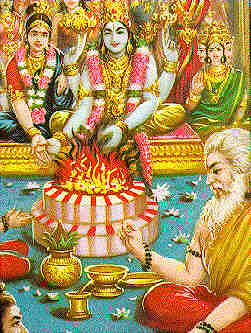 | A Yagna being performed. The officiating clergymen were paid handsomely for this service by kings and the nobility. This payment was called Dakshina. This apart Dana was the customary charity made mainly to the Brahmins. Dana and Dakshina were modes of transferring wealth voluntarily (but enforced by religious and social sanction) from the nobility (kshatriyas) and to the clergy. The Kshatriyas appropriated their part of the social surplus through taxes, tithes, obligatory services from the Vaishyas and Shudras. |
A few days passed and the episode was forgotten by Harishchandra, but Vishwamitra was not one to forget so easily. One day unexpectedly he turned up at Harishchandra' s Court and demanded fulfi11ment of the promise Harishchandra had given him. On being asked what he wanted, Vishwimitra coolly demanded that Harishchandra give up his Kingdom immediately. The King was stupefied; but as per his promise, he abdicated and alongwith his family he left the city.
But he had not gone for when Vishwamitra overtook the royal refugees and said that Harishchandra's word was not yet fulfilled as the dakshina had not yet been given. (the dakshina was a voluntary, but customary, payment made to Brahmins for religious services rendered). Now Harishchandra had nothing with him except his clothes, his wife Saivya and his son Rohitashwa, all their jewels also had been left back at their palace.
Harishchandra pleaded with Vishwamitra to give him a grace period of a month to collect the dakshina which Vishwamitra reluctantly granted. But at end of the said month, Harishchandra had not yet arranged for the dakshina, as no one was ready to offer him work due to his being of noble birth.
On the morning of the last day of the said month, Vishwamitra duly appeared and demanded his dakshina. Harishchandra said that he be allowed time till sunset by when he would some way arrange for the dakshina.
 |
| The morality in ancient India was such that lay people voluntarily rendered free service in the construction of temple panels such as this one from Ajanta which dates back to 5th century. In many such panels the craftsmen have depicted happenings from real life. This panel shows an army marching to war. |
With only a few hours at his disposal, Harishchandra grew desperate and the only way he could think of raising money was by selling himself in the market. He made his way to the public square in the market where slaves were bought and sold and announced that he was for sale. But looking at his lean body, no one was ready to buy him.
Dejected that he was, he asked his wife Saivya if she was ready to get herself sold. The devoted queen agreed to that shameful proposal and she was put up for sale. She was bought by a Brahmin for 500 coins. But when she was being taken away, her son prince Rohitashwa ran after her and said that he too would go with her. Seeing this the Brahmin who had purchased Saivya, said that for an additional 250 gold coins he would purchase the prince as well. Thus with 750 gold coins with him, Harishchandra approached Sage Vishwamitra, but the remorseless sage demanded 250 gold coins more for the dakshina to be respectable.
With no other option before him, Harishchandra put himself up for sale. He was brought by a Chandala (crematorium keeper) for the paltry sum of 250 gold coins. Thus Vishwamitra's dakshina was redeemed. Harishchandra began working as the Chandala's servant. His job was to collect the fee from the relatives of the dead and then arrange for cremation of the dead-bodies.
One day, as if to crown Harishchandra's misfortunes, unknown to him his son Rohitashwa died of snakebite. The sorrowful mother queen Saivya brought his body to the crematorium for the last rites. Little did she know that she would be approaching her husband there. When Harishchandra and Saivya, recognized each other, their sorrow was multiplied. But in spite of this Harishchandra said that if the prince was to be cremated, Saivya would have to give the crematorium's fee. Saivya pleaded that she had nothing to spare, but duty bound that he was, Harishchandra asked his wife to give away a part of the garment that she was wearing as fee. Disbelief clouded her face on hearing this from her husband, but left with no other option she complied. Harishchandra was about to take the garment from his wife.
 | The ethical code of conduct of ancient India was supremely fatalistic and idealistic. So much so, that a word once given had to be kept, even if it reduced a royal family to tatters. We see the same happening in the Mahabharata when the Pandavas go into Vanvas (exile) due to a game lost to the Kauravas. Similar fatalistic attitudes also preserved the caste system and the voluntary acceptance of all its unequal qualifications by the general population. Such was the bizarre ethical code of the ancient Hindu Caste system. Something that very few people from other parts of the globe could comprehend. The Greeks who came with Alexander were the first foreigners to observe this system closely. Greek Chroniclers like Ktesais and Megasthanes have commented upon the Caste system. |
At that moment Sage Vishwamitra appeared and stopped him and declared that Harishchandra's test was over. He told the pathetic king that all this was done to test his integrity. The Chandala for whom Harishchandra worked was none other than Lord Yama (God of Death) himself. On a touch from Vishwamitra the dead Rohitashwa was revived much to the joy of his parents. Vishwamitra declared that Harishchandra could have his kingdom back once again.
After a few days Harishchandra returned to Ayodhya, and was given a tumultuous welcome by his people. He ruled from Ayodhya for a long, happy and prosperous reign
This story of Harishchandra aptly brings out the fact that slavery was a well accepted practice in ancient India. But the existence of a caste structure precluded the necessity for large scale slavery in the form as it existed among the Greeks and Romans.
In fact the Greek historians, who came to India with Alexander the Great, have made eloquent observations about the Indian caste system and tribal way of life as it existed in the Punjab and Sindh, the two provinces which they overran . The Greek chroniclers who came with the conqueror in the 4th century B.C.E. mention that some tribes in the Punjab annually burnt that part of the Grain which was in excess to their own consumption. This was done as ideas of exchange, accumulation and enslavement had not penetrated their tribal consciousness. Hence they remained at a low level of existence unlike their contemporaries in the Ganges valley who had started building the imperial states of Koshala and Magadha.
_________________________________________
Now we move on to examine the nature of the Jati-Varna Matrix of the Chatur-Varna Hierarchy.
_____________________________________________________________
_____________________________________________________________________________________
|
|
_ _ _ |
View My Guestbook
|
_______________________________________
_________________________________
